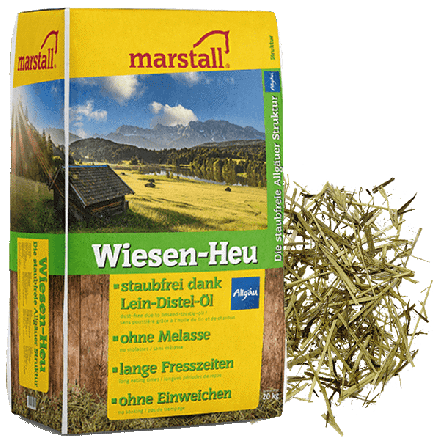Wiesen-Heu
- dust-free thanks to linseed-thistle oil
- no molasses
- for long feeding times
- no soaking needed
Linseed-thistle oil makes marstall Wiesen-Heu a dust and molasses-free hay alternative. This loose chaff with certified origin in Germany‘s Allgäu region is not only suitable as a partial hay substitute but also for promoting longer feeding periods – it can also be soaked for horses with dental problems and/or allergies.
marstall Wiesen-Heu is made from carefully dried hay from highly diverse Allgäu meadows, largely preserving its natural nutrients, vitamins and minerals. Wiesen-Heu is harvested late, this makes it low in fructans and starches and is thus ideal for horses with metabolic problems.
Wiesen-Heu encourages chewing, which in turn stimulates saliva production. It can be used either as a base feed or as a hay replacement or supplement. When mixed with concentrate feed it will also lengthen feeding periods, which is good for the stomach and for digestion.
The addition of linseed-thistle oil makes Wiesen-Heu a source of anti-inflammatory omega-3 fatty acids, liver-promoting silymarin from milk thistle and natural vitamin E. Its nutritional value is higher than normal hay or silage, which means that less concentrate feed is required.
Soaking the loose chaff is not required but recommended for older horses or horses with dental problems.
Feed suoolement for horses
Composition of marstall Wiesen-Heu
Grass, dried at a high temperature (100,00 %)
(Allgaeu highland natural meadow grass, 1st growth, late flowering, chopped and pelleted, vegetable oil (linseed oil, milk thistle oil)
Consisting of a variety of different herbs and grasses such as:
cocksfoot, tall fescue, red fescue, perennial ryegrass, westerwolds ryegrass, timothy grass, meadow fescue, red clover, white clover, bluegrass, oatgrass, golden oatgrass, annual bluegrass, birdsfoot trefoil, meadow foxtail, common bent, Egyptian clover, broadleaf plantain, ribwort plantain, camomile, sweet vernal grass, lady‘s smock, quaking grass, cottongrass, cuckoo flower, crested dog‘s tail, lady’s bedstraw and many more.
EADCM CONFORM ACC.FEI
Nutritional analysis and energy per kg
| Crude protein | 10.30 % |
| pcd* crude protein | 52.00 g |
| Crude fat | 7.50 % |
| Crude fibre | 23.30 % |
| Crude ash | 6.80 % |
| Energy (DE)** | 9.50 MJ |
| Energy (ME)** | 8.00 MJ |
| 0.60 % | |
| Phosphorus | 0.30 % |
| Sodium | 0.05 % |
| Magnesium | 0.25 % |
| Fructan | 6.80 % |
| Sugar | 9.30 % |
*precaecal digestibility = can be digested in the small intestine = available
**acc. to GfE 2014 (Society for Energy Efficiency)
Trace elements
| Copper | 6.50 mg |
| Zinc | 28.00 mg |
| Selenium | 0.10 mg |
Feeding recommendations
... as a high quality hay replacement or partial replacement
approx. 1.0 to 1.5 kg per 100kg BW/day
… to supplement basic feed ration
| Small horse/Pony | approx. 1.0 kg of Wiesen-Heu with 2.0 to 4.0 kg hay |
| Thoroughbred | approx. 1.5 kg of Wiesen-Heu with 3.0 to 4.0 kg hay |
| Warmblood | approx. 2.0 kg of Wiesen-Heu with 5.0 to 6.0 kg hay |
..to mix with concentrated feeds to add texture
approx. 2 to 3 „handful“ under the muesli
Example feed per day for a 600 kg horse to supplement basic feed rations
... as a complete hay substitute
approx. 5.5 to 8.0 kg meadow hay
1 litre of marstall Wiesen-Heu= approx. 100 grams
Feeding advice
Increase the amount slowly at the beginning or mix the Wiesen-Heu with water if it is fed as hay substitute. If the horse eats hastily, is nervous, old or drinks little, we recommend to mix Wiesen-Heu 1:1 or 1:2 with water. Soaking is not necessary!


